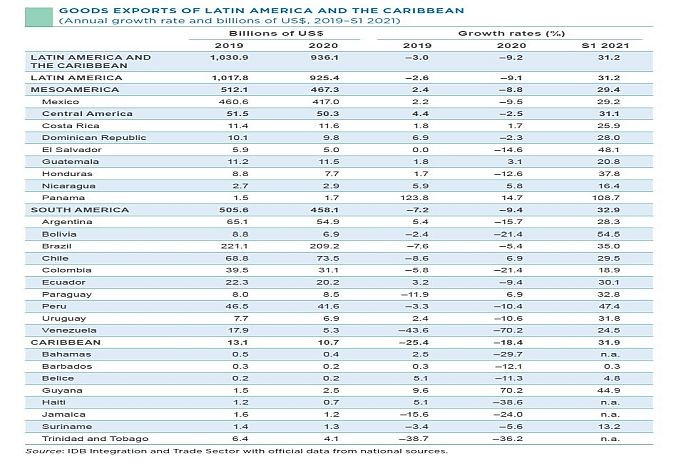WASHINGTON, USA – Exports from Latin America and the Caribbean increased 31.2 percent in the first semester of 2021, driven by the dynamism of external demand, the lifting of restrictions on mobility, and progress of vaccination campaigns against COVID-19, according to a new report from the Inter-American Development Bank.
The rebound puts the region’s external sales of goods 11 percent above the same period in 2019, after falling 9.2 percent in 2020 due to the economic crisis caused by the pandemic.
In contrast, exports of services registered a 33.8 percent drop after contracting 38.5 percent in 2020. More traditional items such as travel and transportation were hit hardest, while intensive knowledge-based services proved more resilient.
This year’s issue of the Trade and Integration Monitor report, which analyzes trade flows in Latin America and the Caribbean through the first half of 2021, projects the continuation of an upward trend in the region’s exports for the rest of the year, despite some signs of a slowdown.
“For Latin America and the Caribbean, importing economic growth from the rest of the world through international trade is critical,” said Paolo Giordano, principal economist at the IDB’s Integration and Trade Sector, who coordinated the report. “The slowdown in export expansion indicates that, to reactivate a cycle of sustained and inclusive growth, it is essential to place external competitiveness at the center of the development agendas of the countries of the region.”
Trade recovery was primarily driven by increases in prices (17.6 percent) and in quantities to a lesser extent (11.5 percent). The volume of external shipments has not yet returned to pre-pandemic levels.
The report notes that while shipments to North America and Asia made the most significant contribution to the region’s trade recovery, intraregional exports (36.9 percent) rallied more than extra-regional sales (30.4 percent). The share of intraregional trade rose by 0.5 percentage points to account for 13.5 percent of the region’s total.
The region’s increase in export prices contributed almost 60 percent of the year-on-year expansion in external sales. This is due mostly to the price performance of the region’s main exports of goods: oil prices increased by 57.7 percent, those of copper by 65.6 percent, iron ore by 104.4 percent, soybeans by 65.7 percent, coffee by 21.1 percent, and sugar by 34.4 percent.
In terms of subregions, goods exports increased by 29.4 percent in Mesoamerica, 32.9 percent in South America, and 31.9 percent for a sample of Caribbean countries.
The region’s imports also regained momentum, growing by 31.5 percent.
A new indicator developed for this study to monitor the progress of Latin American regional integration highlights the need to increase the effectiveness of integration instruments. In comparative terms, the indicator for Latin America and the Caribbean stands below Asia and Europe, and it did not advance significantly in the last decade.
The report concludes that, in order for the external sector to continue sustaining economic growth and social progress, countries in the region must, among other things, advance in the pending issues to further external competitiveness, adapt to the new direction of post-COVID global value chains, strengthen mechanisms for international cooperation and regional integration, and promote complementary policies to improve productivity.





